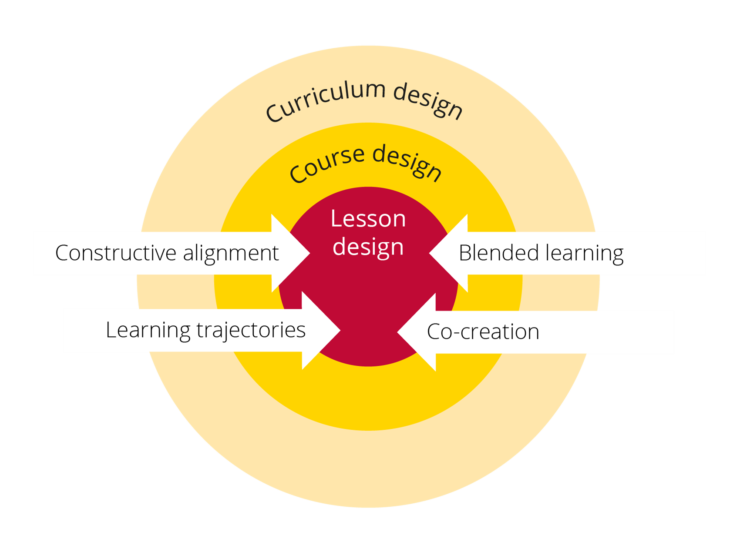Educational design
Educational design concerns the development of goals, assessment, content, (blended) learning activities, teacher role, work format, learning environment, materials for education and study hours (van den Akker, 2003) and combining these into a coherent whole. Educational design happens at different levels; from a single lesson to an entire programme. For the design of a coherent curriculum, the design should lead to constructive alignment and enhancement of competencies in learning trajectories. These subjects are or can be linked to all levels of educational design.

Figure 1. Educational Design, levels and related subjects
Programme Design
A program is a set of courses for which a student may receive a diploma. Developers of a program think about all kinds of educational and organizational aspects in order to put the curriculum together in such a way that students can meet the final objectives of the program and to ensure a viable program. A program must meet all kinds of requirements in order to be in line with the law, the educational vision of an institution and the requirements in the work field. The Utrecht model of education is the educational vision of Utrecht University.
Over the years, a meticulously designed program may lose its coherence due to interim adjustments, or may no longer be up to date. A curriculum scan can reveal whether a revision is possible or whether a complete redesign is needed.
Course Design
New courses that need to be developed are given an assignment because each course plays a role in meeting the programs final objectives. Certain knowledge, skills and attitude must be addressed in the course. Also, the course must fit within the educational vision and intended study culture in the program.
Backward design is a good approach to course design: start with what students should be able to do at the end of the course and then think about what they should learn and practice to be able to pass the assessment. For which learning activities do students need a teacher or other students? Should the learning activities take place face-to-face or online? Should this be during a planned meeting or not? The answer to these questions is based on how the learning activities fit best in an active learning approach and how students learn best as well as on other reasons, such as motivation, the value of meeting a teacher and other students, community development, creating affiliation with the institute and viability.
Course design can well be done in cocreation with students.
Constructive Alignment
Both the program, a course and a lesson must be aligned (Biggs, 2003). This means that content, learning activities and assessments show a coherent connection and contribute to the achievement of the course learning objectives.
Learning trajectories (leerlijnen)
Students develop their knowledge, experience, and attitude gradually throughout the program. To ensure that the necessary steps in the development of competencies continue to have a place in the courses, it helps to appoint content and skills learning lines throughout the program. To monitor these learning lines, programs appoint a coordinator per learning line, who keeps in touch with examination boards and instructors of the courses in which a step in the learning line is planned.
Read more on: Learning trajectories (Leerlijnen)
Blended Learning
Certain learning activities can well be planned online. The careful planning of online learning activities next to face-to-face activities is called blended learning. Utrecht University offers teachers a variety of tools that can be used for online teaching and learning.
UU support on curriculum design
- Stimulation of educational innovation through EMP and USO projects
- Step by step Guide to Course Designco-created by UMCU and UU
- Educational Leadership Programme (EN), Leergang Onderwijskundig Leiderschap (NL
- Professional Consultation
- Workshop Leerlijnentool
- Module Online onderwijs: Context en ontwerp. Leer hoe je je online onderwijs het best kunt vormgeven (Educate-it)
References
- Akker, J. van den (2003). Curriculum perspectives: An introduction. In J. van den Akker, W. Kuiper, & U. Hameyer (Eds.), Curriculum landscapes and trends (pp. 1-10). Dordrecht: Kluwer Academic Publishers.
- Biggs, J. (2003). Teaching for quality learning at university. Maidenhead: Open University Press.

